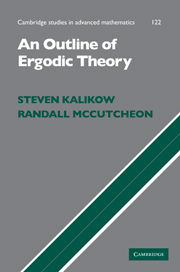5 - Bernoulli transformations
Published online by Cambridge University Press: 05 June 2012
Summary
459. Definition. Let 0 < p < 1. A random variable X has the Bernoulli (p, 1 − p)-distribution if one has P(X = 1) = p and P(X = −1) = 1 − p.
A measure-preserving system (Ω, A, μ, T) is said to be Bernoulli if it is isomorphic to an independent process on a finite alphabet.
460. Discussion. The archetypical deep result of isomorphism theory is the Ornstein isomorphism theorem, proved by D. Ornstein in 1970. There are various formulations of this theorem, of which the best known is perhaps that any two Bernoulli systems of the same entropy are isomorphic. A simplified proof of this version of the Ornstein isomorphism theorem was given by M. S. Keane and M. Smorodinsky in 1979. However, Ornstein's original proof is stronger in that it gives a condition, the so-called finite-determination condition, that is on the one hand both necessary and sufficient for a system to be Bernoulli, and on the other hand is easily checked for a number of specific systems.
Indeed, there are several characterizations of the class of Bernoulli systems of independent interest. Experts in isomorphism theory have long known what these characterizations are, and that they are equivalent to each other, though good expositions on many of the equivalences has appeared only recently; Shields (1996) and Thouvenot (2002) are two examples.
- Type
- Chapter
- Information
- An Outline of Ergodic Theory , pp. 96 - 123Publisher: Cambridge University PressPrint publication year: 2010



